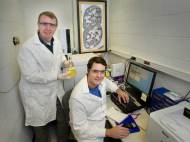Engineered enzyme increases output of biofuel production
 Researchers at the U.S. Department of Energy’s Brookhaven National Laboratory (BNL) have devised a strategy which enables a boost in biofuel production. After studying an enzyme that naturally produces alkanes, the researchers figured how to make its reaction ongoing instead stopping after three to five cycles. The findings renew interest in using the enzyme in bacteria, algae, or plants to produce biofuels without further processing.
Researchers at the U.S. Department of Energy’s Brookhaven National Laboratory (BNL) have devised a strategy which enables a boost in biofuel production. After studying an enzyme that naturally produces alkanes, the researchers figured how to make its reaction ongoing instead stopping after three to five cycles. The findings renew interest in using the enzyme in bacteria, algae, or plants to produce biofuels without further processing.
“Alkanes are very similar to the carbon-chain molecules in gasoline. They represent a potential renewable alternative to replace the petrochemical component of gasoline”, said John Shanklin, Brookhaven biochemist who led the research. “Unlike the process of breaking down plant biomass to sugars and fermenting them to ethanol, biologically produced alkanes could be extracted and used directly as fuel.”
Conducted in large part by former Brookhaven postdoc Carl Andre, now working at BASF Plant Science in North Carolina, and Xiaohong Yu of Brookhaven’s Biosciences Department, the researchers investigated an enzyme known as aldehyde-deformylating oxygenase (ADO).
“We set to work to try to understand the biochemistry of ADO because it is so similar to the desaturase enzymes that we study, but performs a very different and interesting reaction”, said Shanklin.
To simplify the analysis of ADO, the researchers used an approach that had worked for a related enzyme, where thy tested whether they could substitute hydrogen peroxide for the electron transfer proteins and oxygen normally required for the alkane-producing reaction. But instead of stimulating alkane production, no alkane at all was produced, and in control experiments containing all the components plus hydrogen peroxide, alkane production was also blocked.
“It turns out one of the electron transport proteins was interacting with oxygen to produce hydrogen peroxide, and the buildup of hydrogen peroxide was ‘poisoning’ the ADO enzyme, completely inhibiting its activity”, said Shanklin.
To confirm that hydrogen peroxide buildup was the problem and to simultaneously test whether its depletion might enhance alkane production, Shanklin and his team tried adding another enzyme, catalase, which metabolizes hydrogen peroxide to oxygen and water.
“When we added both enzymes, instead of the reaction turning over three times before stopping, it ran for more than 225 cycles”, said Shanklin. “We reasoned that with the ADO and catalase enzymes linked, as the hydrogen peroxide concentration near the enzyme increases, the catalase could convert it to oxygen, mitigating the inhibition and thereby keeping the reaction going,” he said.
Experiments in test tubes and pilot studies in bacteria resulted in at least a five-fold increase in alkane production compared with ADO alone. In addition to removing hydrogen peroxide as an inhibitor of ADO, the bi-functional enzyme actually helps drive the alkane-producing reaction by producing oxygen – one of the key components required for activity.
“While ADO-containing bacteria convert sugar that we feed to them into alkanes, it would be much more efficient to produce alkanes in photosynthetic organisms using carbon dioxide and sunlight”, said Shanklin.
Aside introducing the enzyme in algae or green plants, BNL researchers suggest that the approach of strategically designing fusion enzymes to break down small molecule inhibitors could be used to improve various reactions. Defeating natural inhibition, a process they describe as “protection via inhibitor metabolism” (PIM), would allow such bi-functional enzymes to function more efficiently than their natural counterparts.
For more information, you can read the paper published in the PNAS: “Fusing catalase to an alkane-producing enzyme maintains enzymatic activity by converting the inhibitory byproduct H2O2 to the cosubstrate O2” [769KB PDF].









Leave your response!